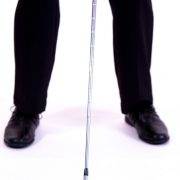Pitch Shot Distance Control

Controlling the distance of your pitch shots is so important that it warrants its own instructional article. As I’ve mentioned with all short game shots, we want to do our best to allow the length of our swing to correlate to the length of the shot. Once we nail down the set up and swing technique, I suggest working on specific benchmark swings that you’ll be able to rely upon out on the golf course.
All pitch shots are performed with a relatively lofted club, with passive hands, without coiling our body or creating excessive lateral motion, and where the club is swung in exactly the same rhythm regardless of the length of swing. My suggestion is to have 3 benchmark pitch shot swings for each wedge, each swing identified by the left arm’s position at the top of the backswing.
The most common and perhaps the easiest to learn is the 9:00 position. This is where our body has rotated and the club has moved back to a position where your wrists are fully hinged and our left arm is parallel to the ground. Hit shots with this length backswing and take note exactly how far the ball is carrying in the air with each of your wedges.
For example, my 9:00 sand wedge carries 55 yards. This is nice to know when you’re out on the golf course and have a similar length shot. After we’ve learned our 9:00 distances, I would also suggest learning our 7:30 and 10:30 benchmark distances for each of our wedges. Like the hands of a clock, these swings are when our left arm is 45°, and 135° respectively. With a little time invested, we will have three pitching yardages for each of our wedges.
So long as we maintain passive hands and consistent rhythm, these distances will not change very much at all from day to day.This is like having extra clubs in our bag. Armed with this technique and distance information, we’ll have a much better chance of controlling our distances and hitting great pitch shots when we’re out on the golf course or under the gun.
In summary, controlling distance is the key element to pitching the ball well. Benchmarking, or at least having a good idea of the distances certain swings produce will help you when you get on the golf course. Get comfortable with a 9:00 swing first, as this is generally the most comfortable length of motion and most common swing to use around the greens. Once we’ve done this with each of our wedges, go ahead and learn the 7:30 and 10:30 distances next. If we maintain our pitching fundamentals, these benchmark distances will not change very much and can be relied upon from one day to the next.









